Touch Operation for Intimate Control
Refined for the smoothest possible operation via touch-panel control, the TF user interface offers a smooth workflow that can be an advantage in any mixing situation. The display content has been specifically designed for easy, direct accessibility, with a layout that promotes the most natural, efficient mixing. Touch panel operation is as easy as shaping the sound with your fingertips.

Touch & Turn Knob Offers Extra Control Precision
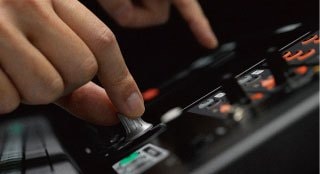
When you need extra precision for a fine EQ or other adjustment, the physical Touch & Turn knob is always available right beside the touch panel. There are also four User Defined Knobs below the panel that can be assigned to control compressor threshold, EQ gain, or other parameters you need fast, direct access to while mixing. The knobs always affect the currently selected channel.
Traditional Overview and Selected Channel Interfaces
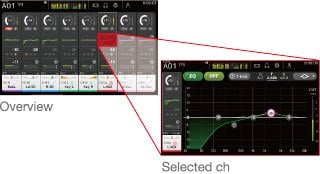
Like the CL series consoles, operation is based around Overview and Selected Channel windows. The overview display shows the parameters for eight channels at a time, while the Touch & Turn knob provides direct access to gain, 1-knob EQ™, 1-knob COMP™, gate threshold, effect send level, pan, and other parameters. Touch the highlighted parameter a second time to switch to the Selected Channel display when you need access to detailed parameters for finer control.
New Features for Smooth Setup and Operation
Effective gain, compressor, and EQ setup requires a considerable degree of skill and experience. Even veteran engineers need to spend time on these important basic settings. In addition to their intuitive user interfaces, TF consoles include a number of features that contribute to faster, smoother setup of these essential parameters.
1-knob COMP™ & 1-knob EQ™: One Knob to Dial In the Ideal Sound
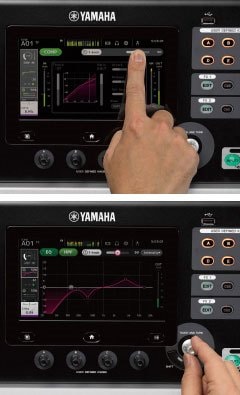
An experienced engineer can do a lot with a compressor: bring a guitar to life, add punch to bass, tighten up a snare, and make vocals ride clearly on the mix. The 1-knob COMP can do all of this quickly and easily, without the need to juggle multiple parameters to achieve the desired effect. Originally introduced in Yamaha analog mixers, the 1-knob COMP quickly became a popular and valued feature. It has now been further refined in a digital version that adds new setup ease and efficiency to the TF consoles. The same concept has been applied in a new 1-knob EQ feature that provides notably improved speed and smooth operation. 1-knob EQ has been painstakingly fine-tuned by Yamaha R&D staff in cooperation with distinguished sound engineers, to ensure that you can achieve outstanding results with minimum effort in the shortest possible time. A Vocal Mode makes it easier than ever to achieve a clear, well defined vocal sound, while an Intensity Mode offers 1-knob “intensity” control over EQ curves you either select from the presets or create from scratch.But there’s more: the 1-knob COMP and 1-knob EQ are provided on the output channels too, so you can quickly achieve overall output compression or EQ that ideally matches the room and audience size. The output 1-knob EQ has a Loudness Mode in place of the Vocal Mode, effectively increasing the sound pressure level while maintaining optimum sound as you rotate the knob. Both the 1-knob COMP and 1-knob EQ provide quick access to the full compressor and EQ displays, so you can fine tune settings as required.
GainFinder™ Supports Precision Gain Setup
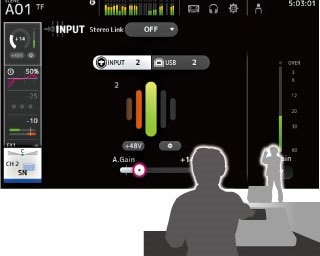
Gain is the first adjustment the input signal sees, and the way it is set up influences how subsequent parameters will affect the signal. Yamaha has developed a way to make fast, accurate setup of this important basic parameter easier than ever. The new GainFinder feature facilitates optimum gain setup for individual input signals so that ideal overall operation and signal quality is achieved. The user only has to set channel gain so that the central green indicator in the level meter remains lit for the longest possible time. Of course the level meters also perform their traditional function, so standard gain setup procedure can be followed if preferred.
Practical Presets and Scenes – Shortcuts to Great Sound
The familiar Yamaha scene memory that stores mix settings for instant recall when needed is included as always. There’s also a range of channel presets that have been created in cooperation with leading microphone manufacturers and eminent sound engineers, providing starting points that take you a long way towards achieving great sound. The channel presets cover parameters such as HA gain, EQ, dynamics, and much more, right down to details like channel name and color. Less time needs to be spent on basic setup so that more time is available for refining the mix and communicating with the performers.
QuickPro Presets™ Provide Instant Access to Pro Sound Setups
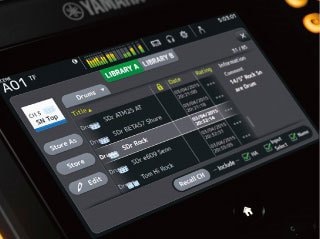
The Yamaha R&D team developed a selection of optimized QuickPro Presets™ for a wide variety of microphones and output equipment by working in collaboration with well-respected engineers and major manufacturers such as Audio-Technica, FitEar, Sennheiser, Shure, Ultimate Ears and Westone Laboratories. With these practical presets even the novice engineer can get very close to the ideal sound, while experienced engineers will appreciate the significant time savings. For input channels we prepared more than 200 presets that range from vocals to drum sets. All the presets were precisely tuned by using a wide range of actual microphones, instruments. For output channels we developed presets for a variety of speaker systems and in-ear monitors such as Ultimate Ears with several variations to match different environments and room sizes. All of these can be used as is when time is tight, but they are also great starting points for manual fine tuning. Setups created from the presets or from scratch can be saved as additional presets too. The 1-knob EQ and 1-knob COMP can be used with QuickPro Presets™ providing a super-streamlined way to tweak your sound. In addition to the onboard presets, new QuickPro Presets™ will be added to the Yamaha Pro Audio website, so be sure to check for updates.
Two Scene Memory Banks

The scene memory features banks A and B, each capable of holding up to 100 scenes. That’s a total of 200 scenes that can be set up and instantly recalled whenever needed. A number of scenes are pre-programmed to give users a head start: scenes with the 1-knob COMP and 1-knob EQ controls engaged for the easiest possible operation, and scenes with the 1-knob features disabled for experienced engineers who might want to follow an established procedure. The banks are great for organizing different types of scenes: one for scenes categorized by music type, and the other by event type, for example.
Design for Superior Visibility and Quick Operation
The TF series hardware is packed with features that contribute to superior operability and convenience. Faders, knobs, and buttons with outstanding fit and feel work seamlessly with state-of-the-art display technology, including high-visibility channel name and color displays. The touch panel itself offers an ideal blend of comprehensive visual feedback and fast response.The physical layout of these components brings everything together in a system that offers surprisingly efficient workflow.
Panel Layout Maximizes Workflow Efficiency
Careful analysis of the workflows favored by a large number of engineers has led to a highly efficient panel layout. Rather than simply providing a long list of advanced features, the TF consoles present meaningful features in the most logical and accessible way through an overall design that maximizes visibility and operability.
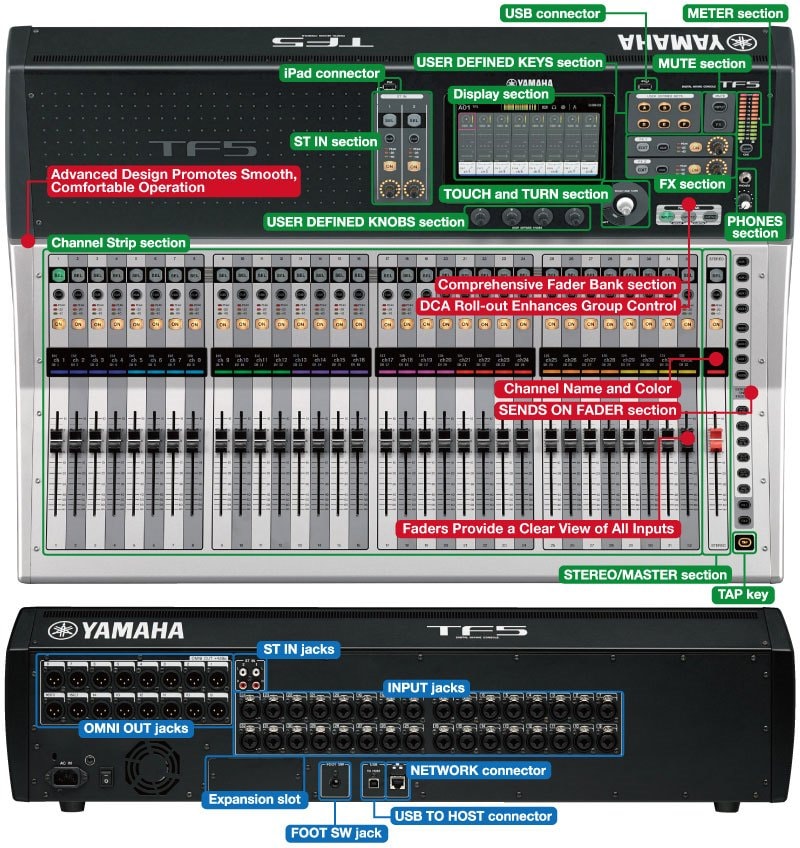
Comprehensive Fader Bank section
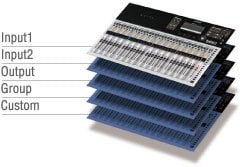
Two INPUT banks and one OUTPUT bank are provided, and the GROUP bank can be selected by pressing both the INPUT bank buttons simultaneously. The GROUP bank allows the levels of multiple channels to be controlled from a single DCA fader. There’s also a CUSTOM fader bank where you can assign any input, output, and DCA group to any fader.
DCA Roll-out Enhances Group Control
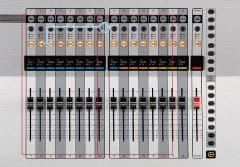
When the GROUP fader bank is selected, all faders other than DCA masters 1 through 8 function as Roll-out faders. Selecting one of the DCA groups instantly “rolls out” the input channels belonging to that group to the Roll-out faders. This useful function makes it easy to adjust the level and other parameters of individual channels while using the eight DCA faders for overall mixing.
Channel Name and Color
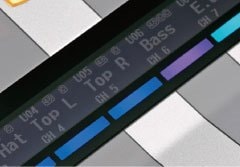
A display panel located above each channel fader shows the assigned channel name or ID, the port name, and the current fader setting. Phantom power status as well as gate and comp operation can also be displayed. A color bar that shows the assigned channel color makes visual navigation a breeze, and prevents confusion when fader banks are changed or scenes are recalled.
Faders Provide a Clear View of All Inputs

The TF5 has 33 motor faders, the TF3 has 25, and the TF1 has 17. All rear-panel inputs have individual faders so their status can be verified at a glance and they can be directly and immediately accessed for control.
SENDS ON FADER section
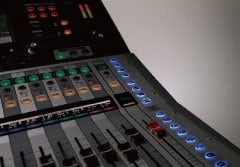
The SENDS ON FADER buttons instantly bring the specified AUX or FX bus levels up on the faders for easy verification and adjustment. When a SENDS ON FADER button is engaged the MASTER fader acts as the master for the corresponding bus, so AUX levels can be checked and controlled without having to switch fader banks.
Advanced Design Promotes Smooth, Comfortable Operation

The upper section of the panel is designed to double as a rest for an iPad, set list, score, memos, and/or other small items. The panel consists of three angled sections that give the operator maximum visibility and access.
Other Features for Efficient Workflow
- USER DEFINED KNOBS section: Frequently used parameters such as compressor threshold and EQ gain, for example, can be assigned for direct, instant access when needed.
- USER DEFINED KEYS section: Assign mixer settings that you use often to these six buttons for instant access, such as direct one-touch recall of specified scenes.
- MUTE section: Multiple inputs or effects can be muted with a single operation.
- FX section: A dedicated channel offers easy effect ON/OFF switching, cue monitor ON/OFF switching, level adjustment, and effect parameter editing.
- ST IN section: In addition to allowing digital playback from an iPad or iPhone or recording/playback with a USB device, you have fingertip control of BGM playback and other audio files.* When using a USB storage device for recording, use a hard disk drive or other high-speed device. (USB memory drives are not guaranteed to function properly.)
Applications that Work Seamlessly with the Console
Separate software applications that allow wireless mixing, personal monitor mixing, or offline setup of digital live mixing consoles have become fairly common. The TF series goes a step further with three dedicated apps – TF Editor, TF StageMix, and MonitorMix – that feature user interfaces that seamlessly extend the console’s own on any device.
TF Editor Facilitates Offline Editing Plus Showtime Control

The TF Editor application for Windows and Mac computers provides a complete interface for offline editing and setup of TF consoles, with scene and preset management capabilities plus convenient keyboard entry of channel names. In addition to being able to set up the console offline at any convenient location and time, the TF Editor can be used online at the same time as the TF StageMix and MonitorMix applications. A Windows 8 PC with a multi-touch screen can use the same gestures as on the console itself. And if using Wi-Fi, a PC can function as a convenient remote-mixing device. Up to three devices running TF Editor or StageMix can be connected at the same time.
TF StageMix™ for Wireless Mixing
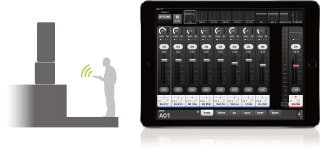
TF StageMix is an iPad application that provides wireless control of TF series consoles, allowing remote mixing from audience seating, in front of floor monitors, or any other listening position. It can also be used at the console as an extension of the console’s own interface. The TF StageMix interface is designed for similar operation and flow to the console display, making it easier than ever to refine the mix from any location.
Personal Monitoring with MonitorMix
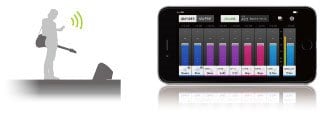
The MonitorMix application for the TF Series allows individual wireless AUX mixing from up to 10 iPad, iPhone, iPod touch or Android devices simultaneously. Each performer can have convenient control over the AUX buses assigned to them, without having to deal with complex settings or parameters. They can also create personal Group settings for even easier adjustment; all levels on just one fader, for example. Since up to three devices running TF Editor or StageMix and up to 10 devices running MonitorMix can be connected at the same time, even large bands can have the personal control they need, reducing demands on the sound engineer.
Smart Looks and Flexible Design for Custom Control Panels
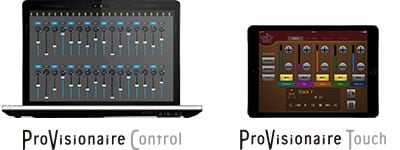
No specialized programming skills are required. An intuitive interface makes it easy to create faders for volume control and switches for channel on/off, for example, and position photographs or other graphic elements on the tablet screen as required to create original control panels that are ideally suited to individual applications and users. In addition, ProVisionaire Touch and ProVisionaire Control can control CL/QL/TF series digital mixers, MTX and MRX series processors, XMV series and PC-D/PC-DI series power amplifiers, R series (ADDA) and Tio1608-D I/O rack, DZR-D series powered loudspeakers and DXS XLF-D powered subwoofers and Nexo NXAMPmk2 powered TD controller. It is easy to combine those parameters onto the one screen
A Natural Sound Foundation with Extra Creative Freedom
Faithful reproduction of the on-stage sound is the foundation, then creativity can take over. Yamaha’s unswerving approach to live sound reinforcement is alive and well in the TF series. The input stage of any console has a notable effect on its sonic character. The TF consoles feature acclaimed D-PRE™ microphone preamplifiers that not only deliver outstanding quality, but are recallable as well. Circuitry and individual components have been reassessed and redesigned where necessary to achieve extraordinarily pure, natural sound. That solid sonic foundation is backed up by an updated selection of high-performance processors and effects. Input and output channel processors such as EQ, gates, and compressors are complemented by eight processors that provide a broad spectrum of creative capabilities.
Recallable D-PRE™ Microphone Preamplifiers
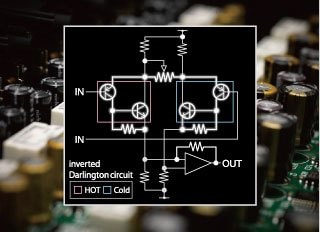
The TF series consoles feature new recallable versions of Yamaha’s acclaimed D-PRE microphone preamplifier. The preamplifiers, or head amplifiers in any console play a significant role in defining the sound of the final mix, so Yamaha engineers spared no effort in developing and refining the D-PRE design to ensure that every nuance and subtlety of the original signal is effectively captured. The circuit is based on a discrete inverted Darlington pair configuration that achieves clean, precise amplification with consistently low noise and distortion at all signal levels. While some microphone preamps are built specifically to impart a unique character of their own, the D-PRE preamplifier has been painstakingly designed with a flat, wide frequency response that retains the tone and nuance of the original sound so that the essence of the performer’s art is captured intact.
8 Powerful Processing/Effect Units and More…
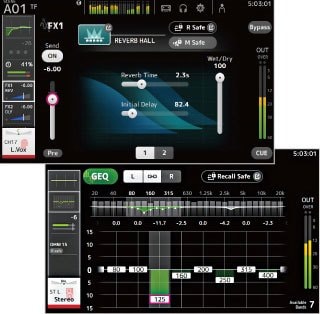
In addition to channel processors, TF consoles feature eight powerful processing/effect units. All the units feature the same type of SPX processors that have become standards in recording and live sound applications, offering 19 programs ranging from reverb and delay, through modulation effects such as flanger and chorus, to multiband compression. With two units of global FX the panel EDIT key opens the effect parameter display where detailed parameters can be adjusted instantly. The remaining six Ins FX are available in the AUX 9/10~19/20 master channels for additional signal control ie. managing levels for in-ear monitoring, or controlling output delay for remotely located speakers using a delay. If more than two Global FX units are required, these Ins effects can be used as additional SEND/ RETURN effects by assigning them to the main stereo bus. The AUX 1~8 buses and main output channels include the same 4-band parametric EQ as provided on the input channels, plus 31-band Flex12 GEQ. Both types of EQ are invaluable for optimizing speaker response and eliminating feedback. These GEQ can also be assigned to the physical faders for more detailed fine tuning.
Revolutionary Dan Dugan Automatic Mixer Built In
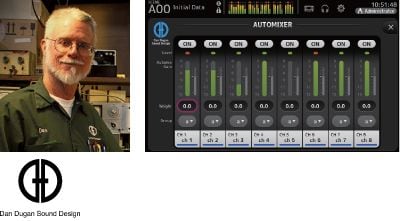
Thanks to in-depth collaboration with Dan Dugan Sound Design, renowned Dan Dugan automatic microphone mixing with its advanced algorithms is built into the TF series consoles. The processor is available for input channel 1-8, you can accsess the setting screen easily from their channel strips for automatically optimized microphone gain distribution. Gain control is smooth and natural, as though experienced human operators were doing the mix. The system also effectively reduces feedback and comb filter issues. For speech applications, especially non-scripted situations, this allows the operator to concentrate on details other than fader operation for consistently high-quality mixes.
Various mix to multiple speaker systems -Matrix Out Channels with Delay-
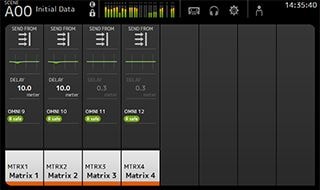
Features:
- 17 motor faders (16 channels + 1 master)
- 40 input mixing channels (32 mono + 2 stereo + 2 return)
- 20 Aux buses (8 mono + 6 stereo) + Stereo + Sub
- 8 DCA groups with Roll-out
- 16 analog XLR/TRS combo mic/line inputs + 2 analog RCA pin stereo line inputs
- 16 analog XLR outputs
- 34 x 34 digital record/playback channels via USB 2.0 + 2 x 2 via a USB storage device
- 1 expansion slot for NY64-D audio interface card
Specs
Mixer
- Number of Analog Input Channels 16
- Number of Mic Preamps 24
- Number of Analog Output Channels 16
- Max I/O Capacity 48 x Input / 22 x Output
Mix Routing
- 1 x Main LRC
- 1 x Subgroup
- 6 x Stereo Aux Send
- 8 x Mono Aux Send
Signal Processing
- Gain/Trim Range -6 dB to +66 dB
- EQ None
- Graphic EQ Yes
- Built-In Effects 8 x Effect (Type Unspecified)
- Real Time Analyzer Yes
- Audio Delay Yes
Digital Audio
- Sample Rates 48 kHz
- Bit Depth Record:24-Bit
- Converter Dynamic Range D/A:110 dB
- Latency :< 2.6 ms (Analog Input to Analog Output)
Performance
- Frequency Response: 20 Hz to 20 kHz +0.5/-1.5 dB;
- Max Input Level Mic/Line Input:+30 dBu
- Stereo Input:+10 dBV
- Output Level Output:+4 dBu (2901653169);+24 dBu (2901653168)
- Analog Dynamic Range :107 dB at Min Gain
- Headphone Output Power: 3 mW;75 mW (Max)
Connectivity
Analog Inputs
- 1 x 1/4" TS Footswitch Input
- 2 x Stereo RCA Unbalanced Input
- 16 x Combo XLR-1/4" TRS Balanced Mic/Line Input
- 2 x Stereo RCA Stereo Line Input
Analog Outputs
- 16 x XLR Balanced Output
- 1 x 1/4" TRS Unbalanced Headphone Output
Recording
- Max Multitrack Recording 34 Tracks
- File Format Support Playback: MP3, WAV
- Record: WAV
Power
- AC Input Power: 100 to 240 VAC, 50 / 60 Hz
- Power Consumption :100 W
- Rack Mountable: No
- Dimensions :20.1 x 8.9 x 23.6" / 510 x 225 x 599 mm
- Weight :29.8 lb / 13.5 kg
Downloads












































